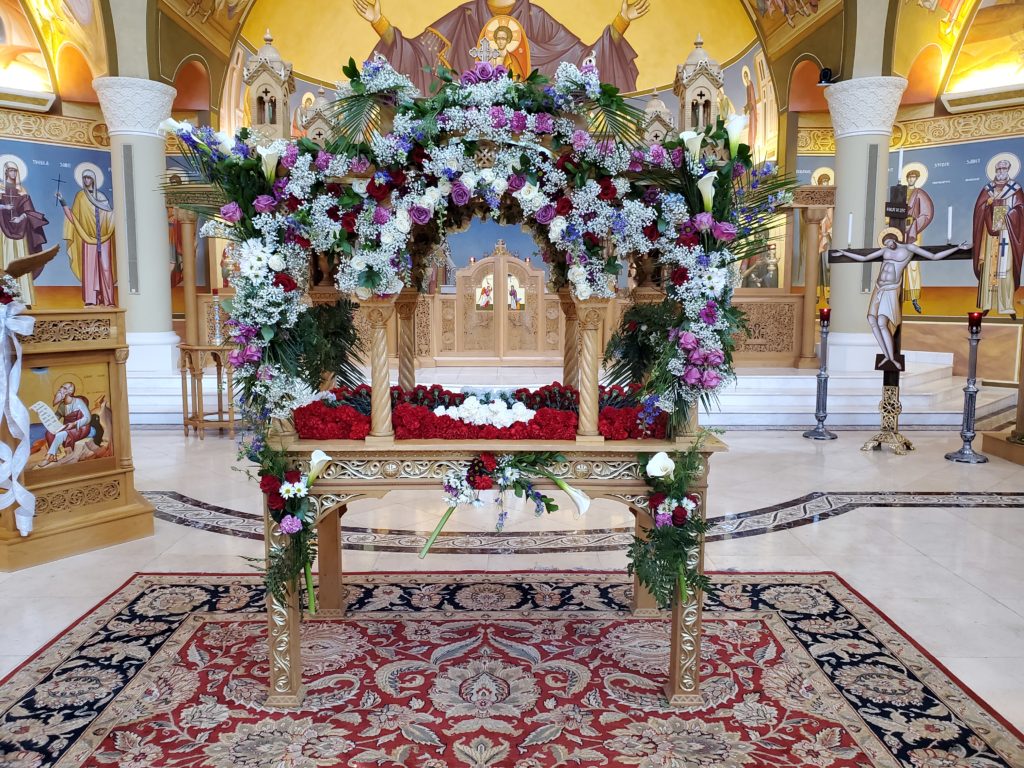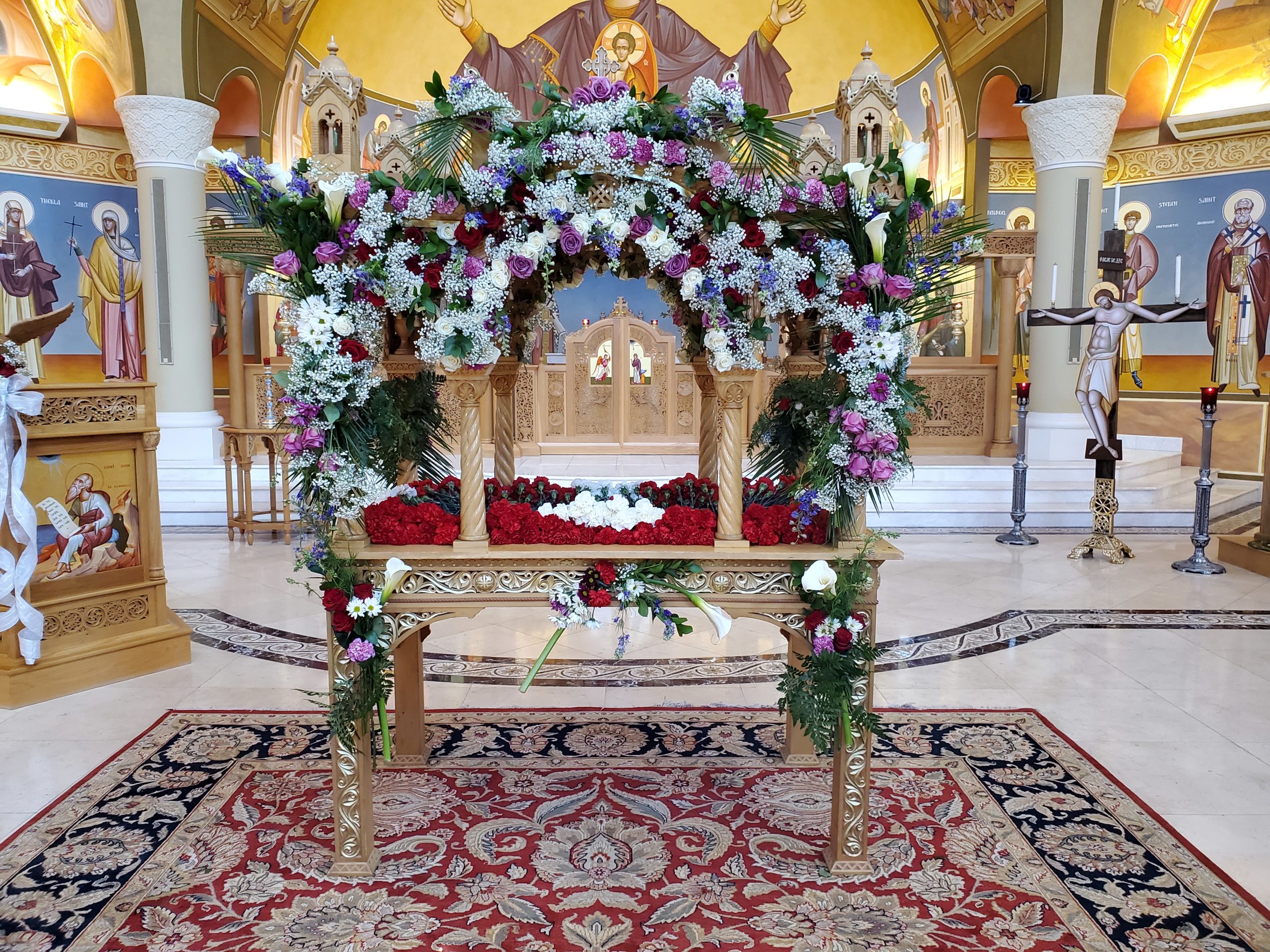The Matins of Holy Saturday are usually celebrated on Friday night. They begin in the normal way with the singing of God is the Lord, the troparion The Noble Joseph, and the following troparia:
When Thou didst descend to death O Life Immortal, Thou didst slay hell with the splendor of Thy Godhead! And when from the depths Thou didst raise the dead, all the powers of heaven cried out: O Giver of Life! Christ our God! Glory to Thee!
The angel standing by the grave cried out to the women: Myrrh is proper for the dead, but Christ has shown himself a stranger to corruption.
In place of the regular psalm reading the entire Psalm 119 is read with a verse praising the dead Saviour chanted between each of its lines. This particular psalm is the verbal icon of Jesus, the righteous man whose life is in the hands of God and who, therefore, cannot remain dead. The Praises, as the verses are called, glorify God as “the Resurrection and the Life,” and marvel at his humble condescension into death.
There is in the person of Jesus Christ the perfect unification of the perfect love of man toward God and the perfect love of God toward man. It is this divine human love which is contemplated and praised over the tomb of the Savior. As the reading progresses the Praises become shorter, and gradually more concentrated on the final victory of the Lord, thus coming to their proper conclusion:
I long for Thy salvation, O Lord, Thy law is my delight (Ps 119.174).
The mind is affrighted at Thy dread and strange burial.
Let me live, that I may praise Thee, and let Thy ordinances help me (119.175).
The women with spices came early at dawn to anoint Thee.
I have gone astray like a lost sheep, seek Thy servant, for I do not forget Thy commandments (119.176).
By Thy resurrection grant peace to the Church and salvation to Thy people!
After the final glorification of the Trinity, the church building is lighted and the first announcement of the women coming to the tomb resounds through the congregation as the celebrant censes the entire church. Here for the first time comes the clear proclamation of the good news of salvation in Christ’s resurrection.
The canon song of Matins continues to praise Christ’s victory over death by His own death, and uses each of the Old Testamental canticles as a prefigurative image of man’s final salvation through Jesus. Here for the first time there emerges the indication that this Sabbath this particular Saturday on which Christ lay dead—is truly the most blessed seventh day that ever existed. This is the day when Christ rests from His work of recreating the world. This is the day when the Word of God “through Whom all things were made” (Jn 1.3) rests as a dead man in the grave, saving the world of His own creation and opening the graves:
This is the most blessed Sabbath on which Christ sleeps, but to rise again on the third day (Kontakion and Oikos).
Again, the canon ends on the final note of the victory of Christ.
Lament not for Me, Mother, beholding Me in the grave, the son whom you have born in seedless conception, for I will arise and be glorified, and will exalt with glory, unceasingly as God, all those who with faith and love glorify you (Ninth Ode of the Canon).
As more verses of praise are sung, the celebrant again vests fully in his somber vestments and, as the great doxology is chanted, he once more censes the tomb of the Savior. Then, while the congregation with lighted candles continually repeats the song of the Thrice Holy, the faithful—led by their pastor carrying the Gospel Book with the winding-sheet of Christ held over his head—go in procession around the outside of the church building. This procession bears witness to the total victory of Christ over the powers of darkness and death. The whole universe is cleansed, redeemed and restored by the entrance of the Life of the World into death.
As the procession returns to the church building, the troparia are sung once again, and the prophecy of Ezekiel about the “dry bones” of Israel is chanted with great solemnity:
“And you shall know that I am the Lord, when I open your graves, O my people. And I will put my spirit within you and you shall live . . .” (Ezek 37.1–14).
With the victorious lines of the psalms calling God to arise, to lift up his hands, to scatter his enemies and to let the righteous rejoice; and with the repeated singing of Alleluia, the letter of the Apostle Paul to the Corinthians is read: “Christ our paschal lamb has been sacrificed” (1 Cor 5.6–8). The Gospel about the sealing of the tomb is read once more, and the service is ended with intercession and benediction.
The Vespers and Matins of the Blessed Sabbath, together with the Divine Liturgy which follows, form a masterpiece of the Orthodox liturgical tradition. These services are not at all a dramatic re-enactment of the historical death and burial of Christ. Neither are they a kind of ritual reproduction of scenes of the Gospel. They are, rather, the deepest spiritual and liturgical penetration into the eternal meaning of the saving events of Christ, viewed and praised already with the full knowledge of their divine significance and power.
The Church does not pretend, as it were, that it does not know what will happen with the crucified Jesus. It does not sorrow and mourn over the Lord as if the Church itself were not the very creation which has been produced from his wounded sides and from the depths of his tomb. All through the services the victory of Christ is contemplated and the resurrection is proclaimed. For it is indeed only in the light of the victorious resurrection that the deepest divine and eternal meaning of the events of Christ’s passion and death can be genuinely grasped, adequately appreciated and properly glorified and praised.
Written by Fr Thomas Hopko in the book, The Orthodox Faith


